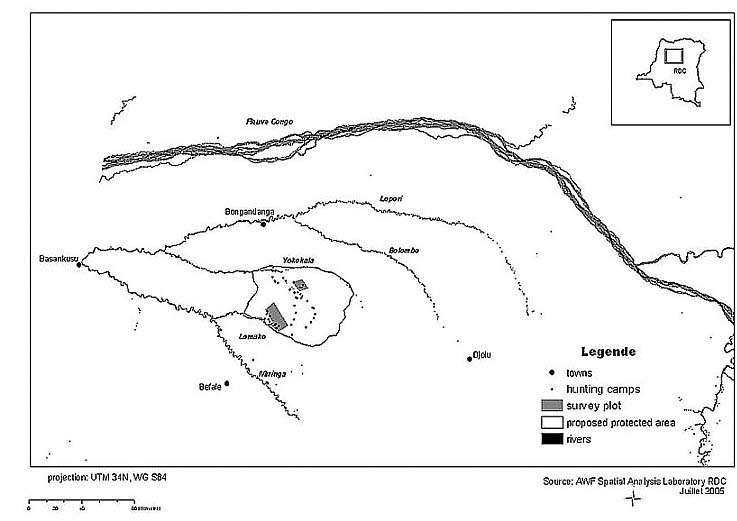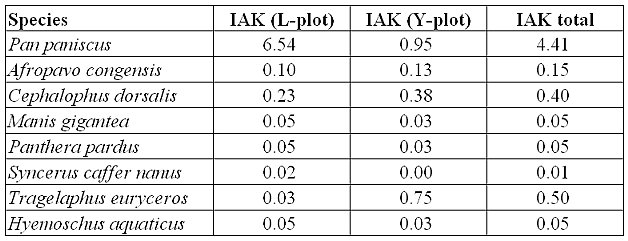|
<NOTE>
Current Status of Bonobos and Other Large Mammals in the Proposed Forest Reserve of Lomako-Yokokala, Equateur Province, Democratic Republic of Congo.
V Omasombo, D Bokelo and J Dupain
Democratic Republic of Congo valomasombo@yahoo.fr, jdupainawfdrc@micronet.cd INTRODUCTION The priorities that are generally identified in conservation action plans for improving the conservation status of Bonobo (Pan paniscus) include a better understanding of their distribution, identification of key areas of high population densities, evaluation of the ecological status of their habitat, evaluating the fragmentation of population and quantification and mitigation of threats to their conservation status1, 2. 
Figure 1. Lomako Forest Map One area that has been identified as critical for the conservation of bonobo is the forest block Lomako-Yokokala (21o05'E, 00o50'N) - situated in the Equateur Province in the "territoire of Befale, District de la Tshuapa and the territoire de Bongandanga, District de la Mongala" (Figure 1). This area historically harbours important populations of bonobos (Pan paniscus), seven other species of primates, potential high densities of Congo peafowl (Afropavo congensis) and other flagship species as the golden cat (Felis aurata), the water chevrotain (Hyemoschus aquaticus) and the giant pangolin (Manis gigantea)1, 3, 4. This forest block of about 3,600 km2 has been identified by the Congolese Institute for Nature Conservation (ICCN) as an area that should receive a protected status5. Initiatives to create a protected forest Reserve between the Lomako and the Yekokola rivers have never been finalized, due to the instability in the country. At the same time, the human pressure on the proposed reserve has increased, and the most recent reports of the bonobo's current status are alarming6. The proposed Reserve is situated in the Maringa Lopori Wamba (MLW) landscape. This is one of the 11 landscapes on which the activities within the Congo Basin Forest Partnership (CBFP) (which is mainly CARPE/USAID-funded) are focussed. Activities within the MLW landscape are coordinated by the African Wildlife Foundation (AWF), and set up in partnership with CARE-International and Conservation International (www.awf.org). The main objectives of the strategy in this landscape are a reduction to the destruction of the tropical rainforest and an increase in sustainable use of the natural resources. One of the specific objectives of the partnership between ICCN and AWF is the creation of the Lomako-Yokokala Reserve.
Before commencing with the gazetting of a protected area, it is necessary to evaluate the existing (or remaining) biodiversity in the region and to identify the priority areas for biodiversity conservation. For this reason, a preliminary biodiversity survey was carried out in August-October 2004. The survey implemented a quantitative bonobo and large mammal survey in two specific forest plots (Figure 1). The first plot (L-plot), situated along the Lomako river (21o4'E; 0o55'N - 21o12'E; 0o48'N), covered the former bonobo study areas that have been active since the 70's. A last visit of this area indicated potential eradication of fauna6. The second plot (Y-plot) is situated along the Yokokala river (21o15'E; 1o6'N - 21o 21'E; 1o3'N) and has been reported to be subject to intensive hunting by population immigrating from the north. As immigration and permanent settlement of a growing group of hunters has been reported7, a directed search for hunting camps was simultaneously conducted in the forest extending between both blocks surveyed for large mammals.
Local guides indicated the presence of hunting camps that were visited in a forest block of about 1,440 km2, stretched between the Yokokala and the Lomako rivers. At each camp, GPS-points were taken, estimates were made of the number of inhabitants and their ethnic origin was recorded.
Table 1. Indices of Abundances per Kilometer (IAK) for flagship species encountered
during the surveys in the Lomako-Yokokala forest block. 
425 bonobo beds (76 bed sites) were recorded along 65 km of transects in the L-plot, vs. 38 beds (9 bed sites) along 40 km of transects in the Y-plot. Distance analysis estimates 81 beds/km2 in the L-plot, and 12 beds/km2 in the Y-plot, resp. When using the conventional bed decay rate of 113 days, one calculates cautiously 0.7 ind/km2 in the L-plot, vs. 0.1 ind/km2 in the Y-plot. The estimated strip width (ESW) in the L-plot was 39 m, vs. 30 m in the Y-plot. While bonobo densities are remarkably higher in the southern plot, the opposite is true for traces of bongo (Tragelaphus euryceros) (Table 1). Little difference was found in IAK's for other large mammals. Signs of the endemic Congo peacock were also recorded at both sites.
35 hunting camps were recorded. The number of people living in these campsites varies between an estimated 7 and 190 inhabitants, totalling almost 1000 people. About 90% of those people belong to the Ngombe ethnic group and only about 10% are Mongo. The principal activity in these camps is hunting. Hunting is done mainly with snares, but guns and "litimbo" i.e. poisoned arrows, were also used. While the biodiversity potential of this forested area still seems to be present, the same can also be said for the threats. Creation of a protected area will have to deal with a significant human population that has settled in this forest block over the last two decades. Most hunters are Ngombe people that are considered as non-autochtonous, as opposite to the Mongo people. In addition, the eastern part of the proposed Reserve is inhabited by Kitiwalist, a religious sect with their own particular set of conditions. A participatory approach involving all the different potential stakeholders involved will be critical to the success of this initiative and help avoid conflicts.
AWF continues to support the ICCN in the creation of the proposed Reserve. At the time of writing, the first meetings for the creation of a CoCoSi (Comité pour la Conservation de Site) - a coordinating committee bringing together all the key stakeholders were held. The CoCoSi will bring together representatives of the local people, other partners, and ICCN. In addition, a mission to start the process of demarcating and digitizing the boundaries of the proposed reserve is currently being organised, together with the ICCN.
Back to Contents |